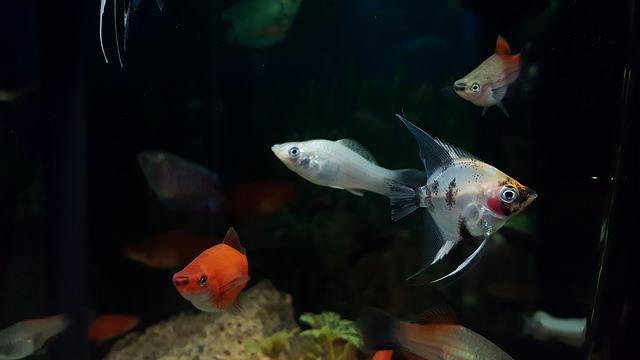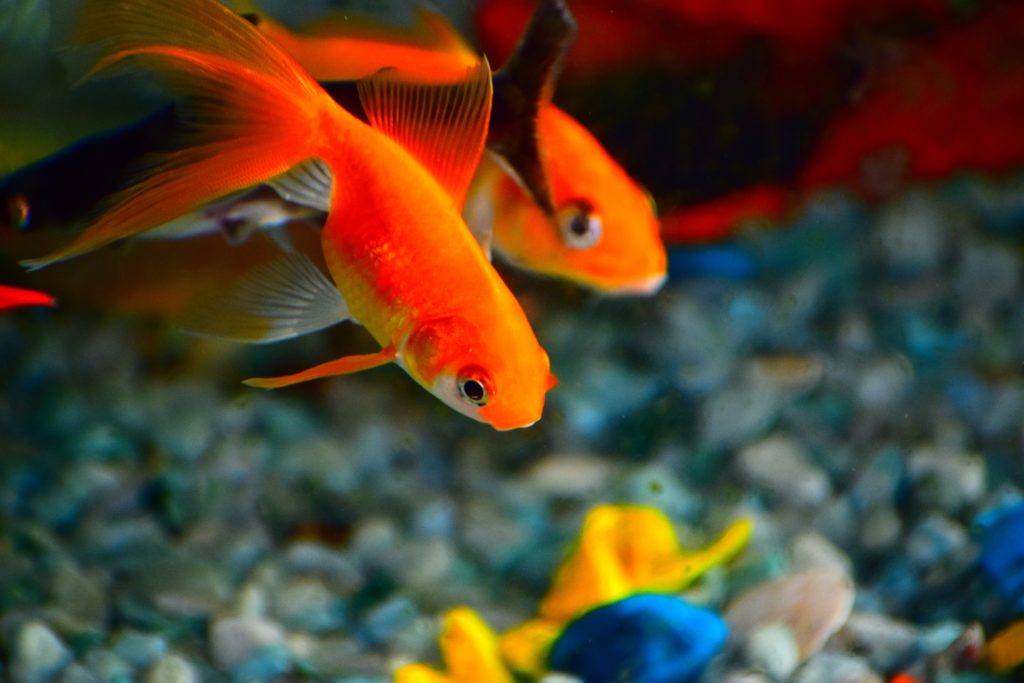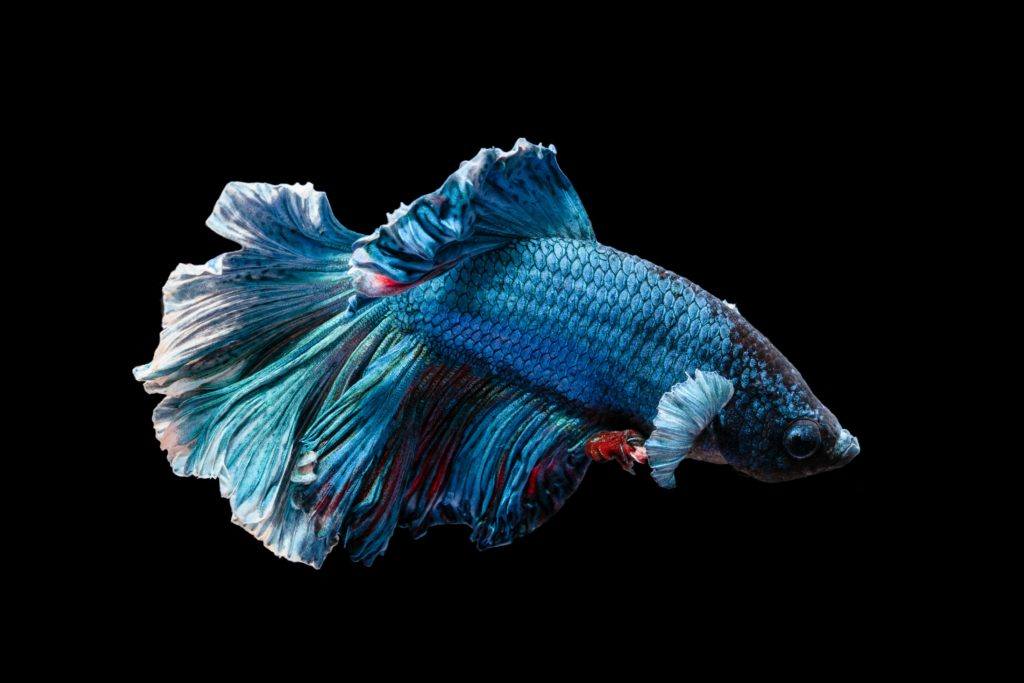A fish’s swim bladder is not an area to hold waste but is instead a crucial organ that helps maintain their buoyancy.
Basically, it allows them to remain at a single point in the water, without expelling energy like they do while swimming around.
It does this by storing oxygen and other gases that the fish gulps up to maintain this buoyancy, much like a diver’s buoyancy compensation device, or BCD.
Some types of fish even use their swim bladder to produce and detect noise within and outside of the tank.
However, if you notice your fish swimming upside down or having trouble staying upright at all, then your fish may be suffering from swimbladder disease.
Symptoms of Swimbladder Disease
Fish who are suffering from swimbladder disease will exhibit problems with buoyancy, or the ability to float properly in the water.
You may discover your fish floating upside down near the top, sinking to the bottom of the tank, swimming sideways, or even standing on their head, which has erroneously led many fish owners to believe their fish is dead.
However, it is quite easy to tell the difference between a dead fish and one suffering from swim bladder disease.
Do not be so hasty to flush it goodbye just yet. If you notice your fish is still able to move their tail or fins about, even while upside down, then it is definitely still alive. Any sign that your fish is struggling to remain upright may indicate they’re suffering from swim bladder disease.
Since the most obvious symptom of this condition is their tendency to mimic a dead fish, floating near the lid of the tank, more often than not, swim bladder disease is also referred to as Floating Disorder.
Your fish may also have a distended stomach or a noticeably curved back as they swim along.
Some affected fish will be able to eat food normally. However, if you notice that they have not eaten for some time, then this could mean that their swim bladder is affecting their ability to rise to the surface in order to feed, or it may be directly affecting their appetite.
Which Fish Can Suffer from Swim Bladder Disease?
Typically, goldfish and betta fish suffer from swim bladder disease more than any other species, but many bony fish are susceptible to this condition as well.
Bony fish are fish with skeletons made of bone tissue as opposed to cartilaginous fish, which are fish with skeletons composed of cartilage.
Typically, any breed of aquarium fish will be a bony fish, whereas fish like sharks or rays are cartilaginous fish. Cartilaginous fish do not have swim bladders and therefore cannot suffer from this condition.
Goldfish (particularly fancy goldfish) and betta fish have round, short bodies that are more susceptible to compressing or even bending the organs inside them.
Couple that with the fact that they are not very good swimmers to begin with, and you can see why these species are more likely to get swim bladder disease.
Keep in mind that some types of aquarium fish naturally swim with their tails higher over their heads. Be sure to ask your seller or research the possible quirks your chosen type of fish may have before assuming the worst.
Causes
Though mistakenly called a “disease,” swim bladder disease is more a symptom of another underlying disease or disorder, and it thus has many different causes.
Compression on the Swim Bladder
The most common cause of swim bladder disease is compression of the swim bladder itself. This is usually due to overeating, eating food too quickly, or even gulping in too much air at once.
Be aware of the type of food you feed your fish. Freeze-dried or dry, flaky foods can expand in water, which will often make your fish’s stomach or intestine expand and press against their swim bladder.
Low water temperature will also slow your fish’s digestion, and can even lead to an enlargement of their intestines due to constipation.
Again, this enlargement can create a temporary compression against the swim bladder that will result in a bout of swim bladder disease.
Other causes of swim bladder compression come from the enlargement of other nearby organs, too. Kidney cysts, fatty deposits in the liver, or egg binding in females can also lead to a compressed swim bladder.
Parasites or Infections
Infections and inflammation of the swim bladder can occur due to either bacteria or parasites found within the tank.
In addition to other swim bladder disease symptoms, your fish may also have clamped fins, begin to shake, or refuse to eat if they are also suffering from an infection.
Birth Defects
Some fish are born with a defect that impacts their swim bladder, but such cases are rare and the symptoms typically show up from a very early age, making it easier to identify – but harder to treat.
A Hard Blow to the Body
If your fish suffers a hard blow to their body, either from striking an object in the tank, a fall, or even a fight with another fish, your goldfish’s swim bladder may become damaged, leading to more permanent issues.
This can include a permanent case of swim bladder disease.
Poor Water Quality
An often overlooked cause of swim bladder disease is poor water quality. Poor water quality can (and will) stress out your pet fish if left unchecked for too long.
In turn, this stress can lead to a disruption of their homeostasis, or the physiological equilibrium their body should have at all times.
Basically, too much stress can have an adverse effect on your fish’s buoyancy in the water, leading to swim bladder disease.
Can Fish Die from Swim Bladder Disease?
Short answer: No, they cannot.
However, there are some fish that will suffer from swim bladder disease permanently, even after you make modifications to their tank or lifestyle.
Simply keep in mind that these fish still manage to live very full and healthy lives despite their conditions. If your fish does not appear to be distressed by it, then you do not need to be either.
Is there a Swimbladder Disease Cure?
Due to there being many different causes for this condition, there is also no one swim bladder treatment method, either.
If your fish happens to live in a community tank, be sure to take them out and place them in a clean tank of their own.
Again, while swim bladder disease is not a disease in the traditional sense, it is best to keep the afflicted fish isolated until you can determine the cause of their distress.
Be sure to keep their tank clean all throughout the day and do not feed them for three days, so as to allow their digestive system to rest.
Make sure that both your community tank and the isolated tank have water temperatures anywhere between 70 to 80 degrees Fahrenheit to help your fish digest their food faster.
After this, it is best to consult your veterinarian for advice.
Diagnosis
It is always important to discuss your treatment options with your veterinarian and see what course of action is the best for your fish.
Your veterinarian will ask you questions about when you believe this all started, as well as if the fish has any history of the disease prior to the visit.
Typically, your vet will confirm if your fish has swim bladder disease by conducting an X-ray. Your doctor will also be able to see if the swim bladder is enlarged, filled with liquid, or even displaced due to another disease.
This video explains more on swimbladder disease treatment.
Cure for Compressions
If your fish’s disorder is due to compression on the swim bladder unrelated to a hard blow or birth defect, then it will be quite easy to treat.
Typically, if you leave your fish isolated in a clean tank and do not feed them for three days, this alone will be a satisfactory swim bladder cure, as any constipation due to overeating or gulping in excessive air will have passed in this time.
If you have a betta that experiences difficulty breathing, be sure to only fill their isolation tank by a few inches. Also include a plant or some form of decoration for them to rest on, so they can rest closer to the surface.
On the fourth day, after you have cleaned out their waste, you should prepare some cooked peas for your fish. This is because peas are high in fiber, and will definitely ease a fish’s constipation should it continue after their fast.
Typically, thawing out frozen peas will work best, as fresh peas could have harmful pesticides included on the food. Be sure to remove the skin from one pea, chop it into smaller pieces, and feed those pieces to your fish.
Do not feed your fish more than one or two peas a day. If necessary, you may need to hand-feed your fish the pieces until their swim bladder symptoms have passed.
Be sure to sprinkle a pinch of aquarium salt into the isolated and community tanks to aid in the healing process and to prevent any more infections.
However, if the compression is due to problems from other organs, such as an enlargement of the kidneys or liver, then your veterinarian may have to perform certain operations to have this fixed. Your fish may even need to have part of their swim bladder removed.
Cure for Parasites and Infections
If you find that your fish’s swim bladder disease is due to a parasite, an infection, or from poor water quality in the tank, then the swim bladder treatment is as easy as cleaning their tank and better maintaining the aquarium.
Again, sprinkling a pinch of aquarium salt can help to prevent any other infections from cropping up.
If problems still persist after this, consult your veterinarian before using broad spectrum antibiotics. These typically come in water droplet form and even medicated fish food flakes.
Follow the instructions on the package very carefully, as overmedication may lead to other problems that further harm your fish.
Final Notes About Internal Damage and Birth Defects
Unfortunately, if your fish has suffered a harsh enough blow to their body, then it is very likely that the damage to their swim bladder is permanent.
The same can be said if your fish was simply born with a birth defect that affected or even stunted the development of their swim bladder.
You can use the treatment options listed above, but just know that if your fish does not appear to be distressed by their condition, then they can still live a full and happy life despite it all.
Swimbladder Disease Prevention
Please note that while you may have been able to treat your fish’s swim bladder disease for the time being, they always have a chance of coming back, especially in goldfish and betta fish (mainly due to their body structures).
To prevent this from happening, you should switch your fish’s diet toward more sinking or neutrally buoyant foods. These can help keep any excess air from being sucked up and filling up the swim bladder.
You should also be aware of the amount of food you feed your fish.
Always make sure your aquarium remains clean and routinely stays at a water temperature between 70 to 80 degrees Fahrenheit.
The warmer water will not only help your fish digest their food more quickly, but it will also allow your fish to live much better than they would in colder waters.
This video explains more on how to prevent swimbladder disease in your tank.
https://www.youtube.com/watch?v=QHBsYMpAjdE
Conclusion
Swim bladder disease may appear to be a highly worrisome condition, but more often than not, it is a simple condition to treat.
Fish owners, and especially fancy goldfish and betta fish owners, must always be mindful of their pets’ environments and how that affects them.
You must also keep in mind how much and what kinds of food you feed your fish. With the proper care, you are ensuring that your watery friends will continue to thrive!
Do you have experience treating swimbladder disease?






